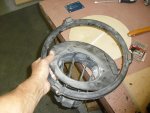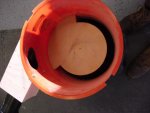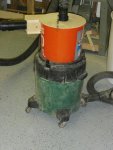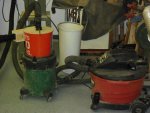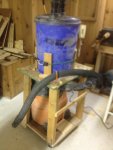Ryan, I base this unit largely from Matthias Wandel design. His is a hybrid of a Thien baffle and a cyclone, thus the greater distance between the lid and the baffle. How thin and how did you support a thin baffle? I went with the 3/4" so that the screws would have enough meat to support the baffle in place.
My design is substantially different and my baffle is actually supported by the separator body pretty well (I built the "top hat" design so the supporting area of the baffle is inset into the walls of the separator) so it won't translate directly to your build but I ended up about 1/4" thick with the edges feathered a bit thinner (mine is actually sheet metal topped plywood routed to thickness - I don't advocate going that route in anyway shape or form

). I know some have managed to use as thin as 1/8" hardboard but that can get a bit wobbly although it might work in as small of a space as you have here. Most common seems to be 1/4" tempered hardboard (smooth side up). Soaking the edges in a bit of glue and then buffing them smooth also seems to help eek out that last smidge of performance (I did basically that more or less).
With your setup the challenge will definitely be to figure out how to support a thinner baffle. My best idea (I've seen some other builds that did similar and claimed to work so its not really "my" idea) would be to suspend it from the lid with some standoff posts. You'd want to make sure any penetrations through the lid were sealed up really good but it would be a fairly simple change and I believe it would also make emptying the collector easier. Interestingly the supporting posts don't seem to have any meaningful impact on airflow.
Here's an ancient post by some random guy named Vaughn

that illustrates roughly what I'm thinking of (except as usual its upside down from the way I think)
http://www.jpthien.com/smf/index.php?topic=145.0
Side note: there is a ton of good info in on Phils forum.. if you can find it!!
The width of the opening I went with is 1 1/4". It is less that what Thien, called for in a PDF file I found. He stated the baffle can be scaled to what ever size but the gap size of 1 1/2" is a constant.
I'm not going to tune this unit for the planner or jointer. I have an old Grizzly 1hp with 4" hose for those. I feel the important machines to tune to are the ones that make the finest dust, IE my sanding machines, router table, and band saw (if I can figure a way to get my bs closed up enough)....
Yeah as general advce the 1.25 - 1.5" gap is generally good but my experience (and comments I've seen from others) indicates that a narrower slot == better separation up until airflow or material flow is compromised. I started at 1" and got really good separation with the table saw and sander. When I hooked up the planer to it it instantly clogged. Opening up the gap allowed the planer to work but now I see a bit more bypass with the tablesaw and sander dust (not a lot but it went from sparkling clean filters to observable dust). Since this is a high pressure low volume setup my intuition claims that a narrower slot will work quite a bit better - I might try 3/4" or even 1/2" and see how it works. If you do the suspended baffle then opening it up more is pretty easy to do so the risk would be fairly low.
I will try moving the existing baffle up closer to the inlet and see what happens. I need to caulk around the bottom of the bucket too so there are less air leaks. Another "work in progress"!!
I'd bet any gains will be marginal with the thicker baffle but am definitely curious to hear how it works.
Speaking of air leaks,
ANY air leaks in the bucket/baffle system (and I mean ANY)
will throw all other enhancements, tuning, adjusting, performance completely out the window. This goes for both the top and bottom of the airspace. If you haven't done it yet I'd put some sort of gasket material around the lid seal and aggressively hunt down all air leaks (a stick of incense is handy for this.. just move it around and see if the smoke moves). This was definitely one of the harder parts of getting my system to work and when I spent the time to do it helped a lot.


